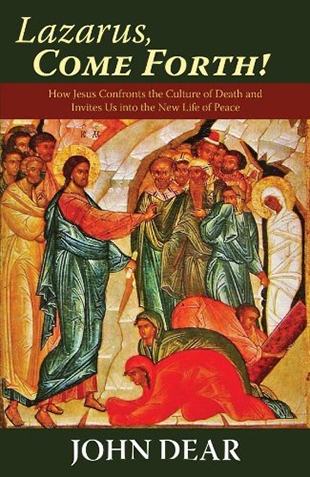"As with all of John's stories, there is always a sense that he is nudging us, by means of signs, in the direction of a larger reality, a truth beyond simple telling. Scholars have long acknowledged that John's stories work on multiple levels: the level of the narrative and the level of allegory — a kind of collective meaning that rises off the page. With the suppleness of a poet, John turns us toward his precious discovery: resurrection is here and now, for one and all.
"And if we are free to defy deathly institutions, we are now free to pour out our lives in service to death's victims, to offer compassion, to secure justice, to inoculate the world against its own violent ways, to beat swords into plowshares and study war no more. We are freed to live as if death has no dominion this side of life.
"It is an audacious thesis. But on this John bases the very life of the nonviolent, life-giving Jesus. In John's Gospel, Jesus' very life bespeaks resurrection. Wherever he goes, his disarming presence leaves merciless death embarrassed and impotent. Threats and dicey situations abound, but Jesus faces them with fearlessness and truth. The downtrodden who cross his path feel better, more dignified, because here is one with not a trace of violence in him.
" 'Jesus,' Daniel Berrigan once said to me, 'didn't have a mean bone in his body.' His life, all said, was a life of perfect nonviolence — a life which in the end could not be contained by death. It was a risen life even before resurrection had ever occurred. And John, in his roundabout way, sets this thesis before us.
"We too are summoned out of the culture of death into the way of nonviolence. All of us are called to share the risen life here and now. In John's Gospel we hear the invitation over and over: 'Enter eternal life today. Do not do the works of death. I have come that you might have life and life to the full. Whoever believes in the God of life will have nothing to do with death. Live in the new freedom of love and peace!'
"In chapter 11 the action reaches its peak. We hear that Jesus' friend Lazarus has died. But in this context, Lazarus is more than a friend of Jesus. According to theologian Monika Hellwig, Lazarus represents humanity. If this is true — and I submit that it is the key to the entire Gospel — then John has taken us into deep waters. The story of this raising is John's way of dramatizing how Jesus has come to call everyone and every culture out of the tombs of death into the new life of peace."
